Transplanting seedlings into your garden is exciting. But you have to do it the right way and at the right time, or they may not survive the transition. So in this post, I’ll show you exactly when and how to transplant your seedlings.
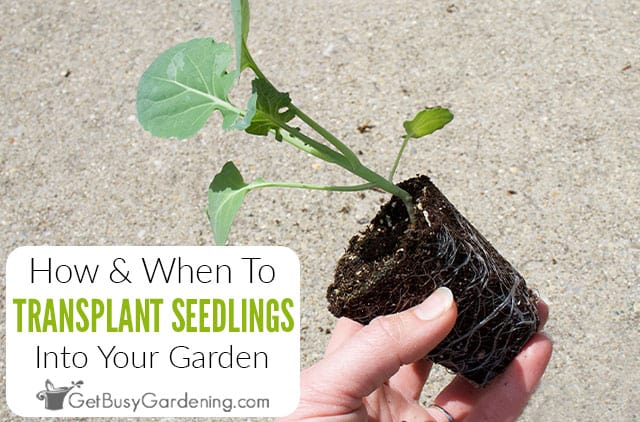
Spring weather is unpredictable, and it can be hard to figure out when it’s safe to transplant seedlings into the garden.
If you do it too early, it will result in frustration if a late frost kills all of your hard work, and you have to replant everything. Ugh!
You spent all that time caring for your seedlings indoors, so you certainly don’t want them to die as soon as you plant them outside. Right? Of course not!
Don’t worry, I’m going to make this easy for you. Below I will tell you the best time to transplant seedlings, and show you exactly how to do it step by step.
Preparing To Transplant Seedlings Into Your Garden
But hang on one second… Before we talk about when to transplant seedlings into the garden, I want to make sure that you have properly prepared them for the big move.
You can’t take them from your warm and cozy home, and put them straight into the garden. That would likely be disastrous.
Instead, you need to harden them off first to get them ready for life outside. Whatever you do, do not skip this step!
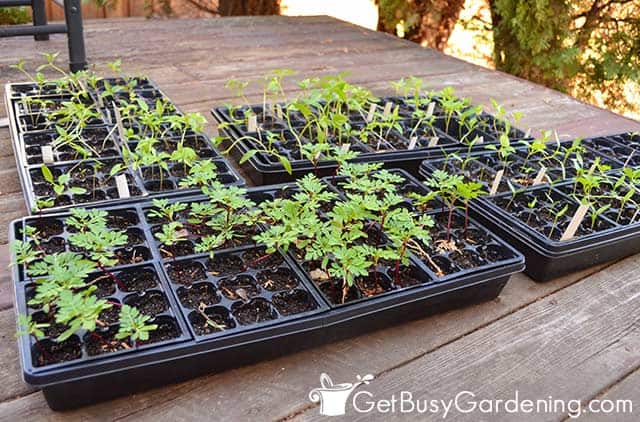
When To Transplant Seedlings
The exact date for when to transplant seedlings outside depends on a few factors. It comes down to where you live, the consistency of the soil, and what types of plants you have.
How To Figure Out The Exact Timing
To get the timing right, the first thing you need to know is your average last frost date. If you don’t know what that day is in your area, check with a local garden center.
Subtract two weeks from that date, and that’s when you can plant cold hardy starts. Then, on average, you should wait until two weeks after that date to transplant your non-hardy seedlings.
But, since it is only an average, some years there will be a frost later than that date. So, use these numbers as a rough gauge.
Then keep an eye on the forecast, and wait two full weeks after the last frost to plant the tender stuff. It’s always better to wait a week or two, rather than planting heat-loving seedlings too early.

Make Sure The Soil Is Ready
You may have heard that you should wait until the soil is workable before you transplant seedlings into your garden. But what does that mean?
The soil is workable when it has thawed completely, and is no longer saturated with water from the snow melt.
You should never try to work the ground when it is soupy or sticky. It should be moist and fluffy.
It’s easy to check to see if it’s ready. Simply grab a handful of soil, and try to make a ball with it in your fist.
If it crumbles rather than sticking in a ball, then it’s ready to be worked. If it sticks together, then wait a few days and check it again. Sandy soils will dry much faster than clay.
Wait For The Best Weather To Transplant Seedlings
This may come as a surprise, but the weather is an important factor for deciding the best time to transplant seedlings into your garden.
Ideally, you should choose to do it on a cloudy day when there’s light rain in the forecast. Avoid days that are hot, sunny, or dry, because that can increase the risk of transplant shock.
If there are no clouds in sight, then plan to do it either in the early morning or in the evening. That way, you will avoid the peak of the hot afternoon sun.
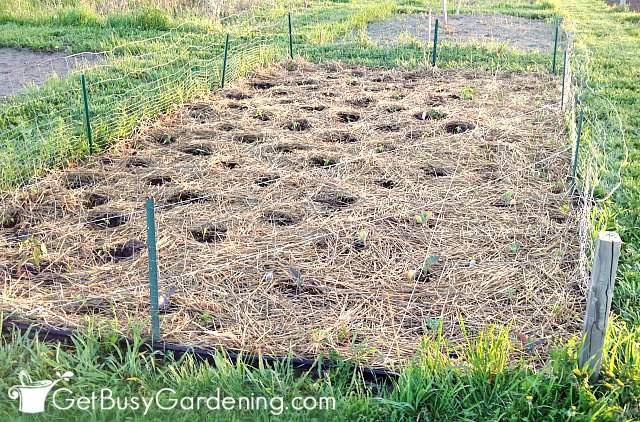
How To Transplant Seedlings (Step By Step)
Once you get the hang of it, you’ll see that the steps for transplanting seedlings are very easy. To make sure you’re doing it the right way, simply follow these instructions.
Step 1: Move aside any mulch – If you have mulch in your garden, then push it aside to allow enough space to plant each seedling.
You don’t need to remove all of the mulch from the bed, that would be way too much work! Just brush it aside in the spot where you want to put each seedling.
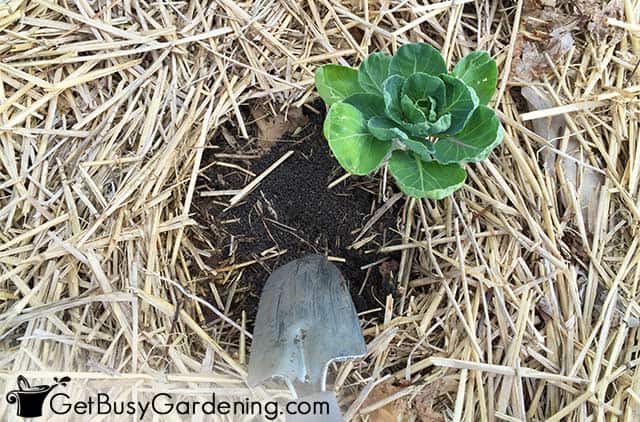
Step 2: Dig a shallow hole – Make your planting holes twice as wide and deep as the container or plant cell.
Add some organic granular fertilizer, compost, and/or worm castings into the hole first. That will help your newly planted seedlings become established faster, and grow stronger.
Step 3: Remove the seedlings from the tray – Be very gentle here. Never pull them out or hold onto them directly, or you could break their delicate stems.
Instead, carefully slide them out of the container, while holding onto the rootball only.
To do this, turn them upside down, and place your fingers on either side of the stem. Then pinch or squeeze the bottom of the container until it’s loose enough to come off easily.
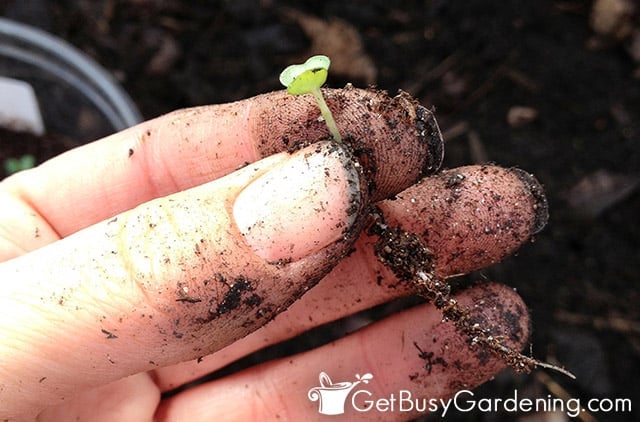
Step 4: Plant the seedling – If the roots are completely pot-bound, then you can gently tease them apart to loosen them up a bit. Be careful though, because some plants hate having their roots disturbed.
Place your starts into the hole at the same depth as they were in the container. Backfill the hole with dirt as you need to so they aren’t sitting too deep.
Step 5: Fill in the hole – Center the rootball in the hole, and fill the rest of it to completely cover all of the roots.
Then gently pack it down to ensure the seedling won’t settle too deep into the soil after transplanting.
Step 6: Water your garden – Using the lowest setting on your garden hose, water each seedling deeply. This will help to minimize the risk of severe shock.
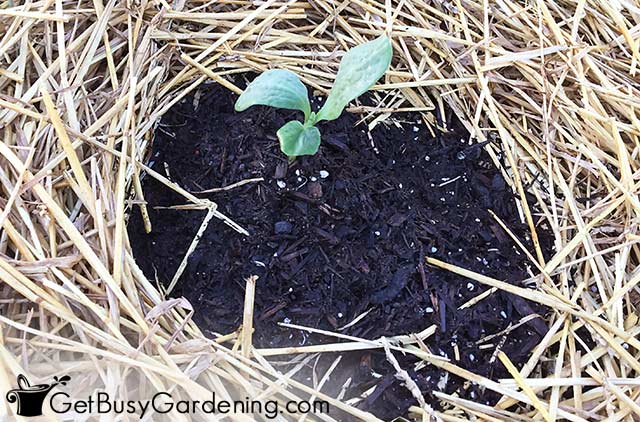
FAQs
Below I will answer some of the most common questions I get about transplanting seedlings. If your question isn’t answered here, ask it in the comments below.
What happens if you transplant seedlings too early?
If they are transplanted too early, seedlings are at a much greater risk of dying from a late spring cold snap. Even hardy starts will likely die if the temperature goes below freezing for any length of time.
I know it can be hard, but waiting a little longer is always the safest bet. If you accidentally plant them out too soon, then protect them on cold nights using row covers, a plant tarp, or a frost blanket.
How big should seedlings be before transplanting?
Ideally before they’re transplanted, seedlings should be at least twice as tall as their starter trays. So, that would be about 3-4″ tall.
However, I have planted ones as short as 1″ tall in my garden before with no issues. But, the larger they are, the easier it will be for you.
How do you transplant small seedlings?
It’s best not to transplant seedlings when they are still small. Instead, wait until they are at least twice as tall as the tray.
Then, start them earlier next year so they have plenty of time to get large enough before they go outside.
Transplanting seedlings into your garden can be a scary thing. But as long as you follow the tips and steps above, you will have the best success.
If you’re tired of struggling, and want to learn how to grow any plant you want from seed, then enroll in my online Seed Starting Course. It’s a wonderful, fun, self-paced course that will teach you everything you need to know to easily grow your own seedlings. Enroll and get started today!
Or, if you just need a refresher, then my Starting Seeds Indoors eBook is for you! It’s a quick-start guide that will get you planting seeds in no time.
More Posts About Seedlings
- How To Fix Common Seedling Problems
- How To Repot Seedlings Into Larger Containers
- How To Get Rid Of Mold Growth On Seedlings & Starter Pots
Share your tips for transplanting seedlings into the garden in the comments section below.
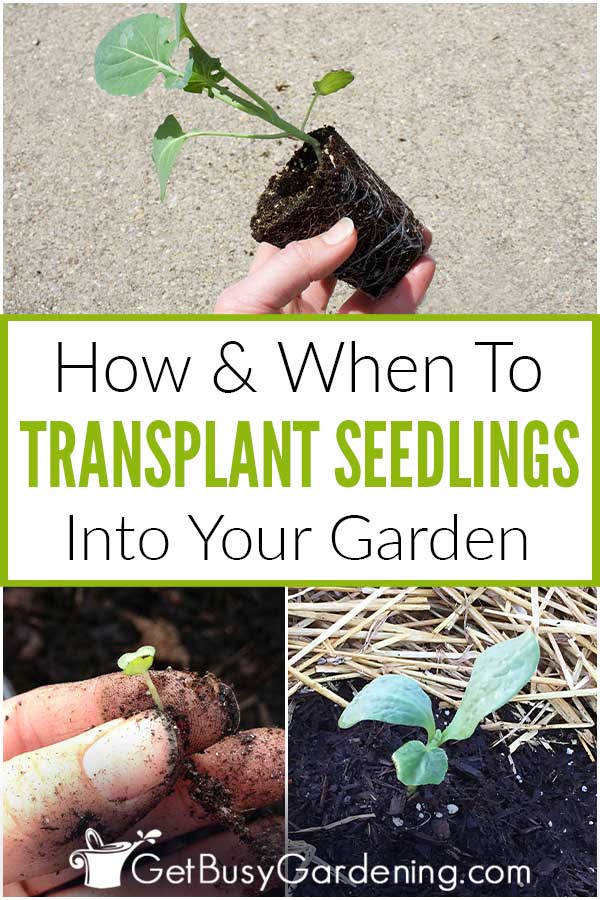
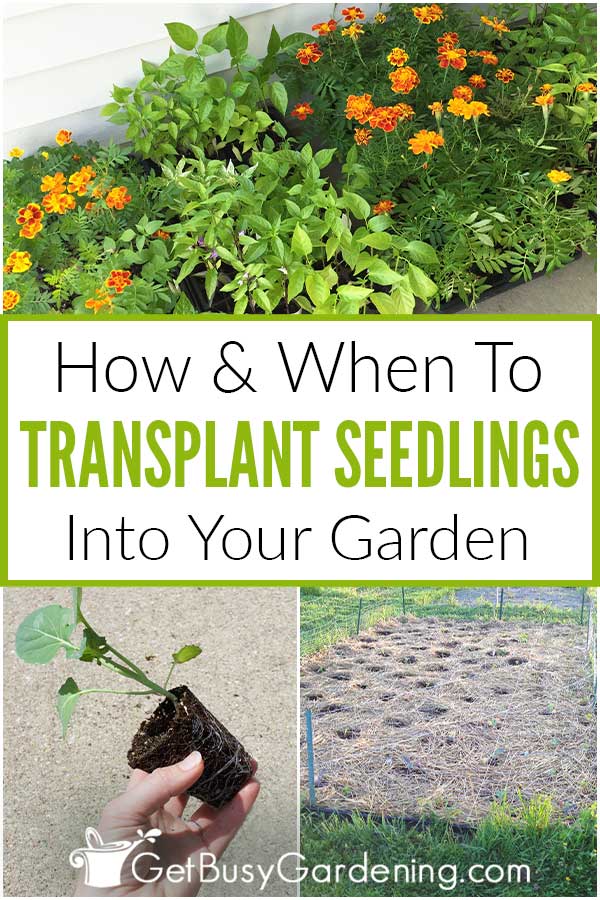
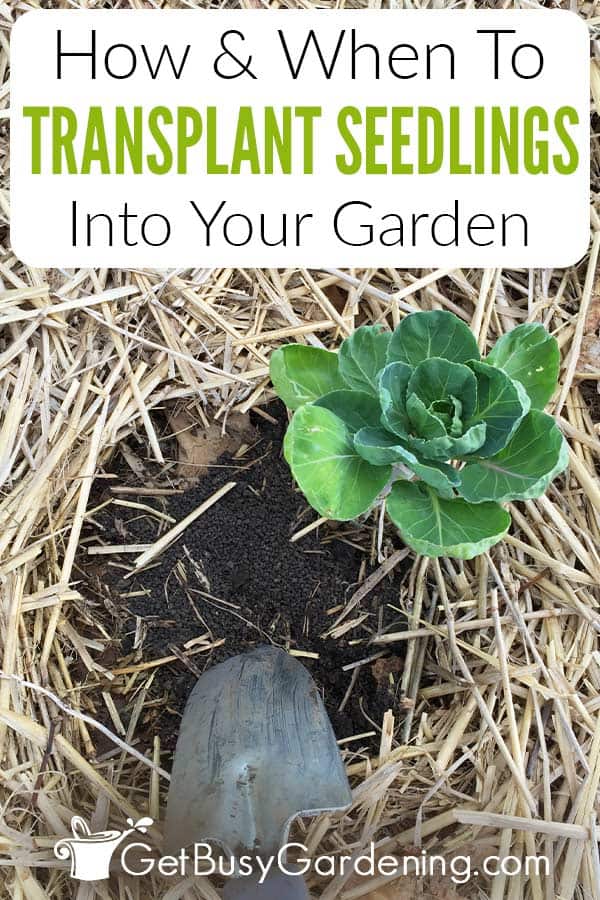
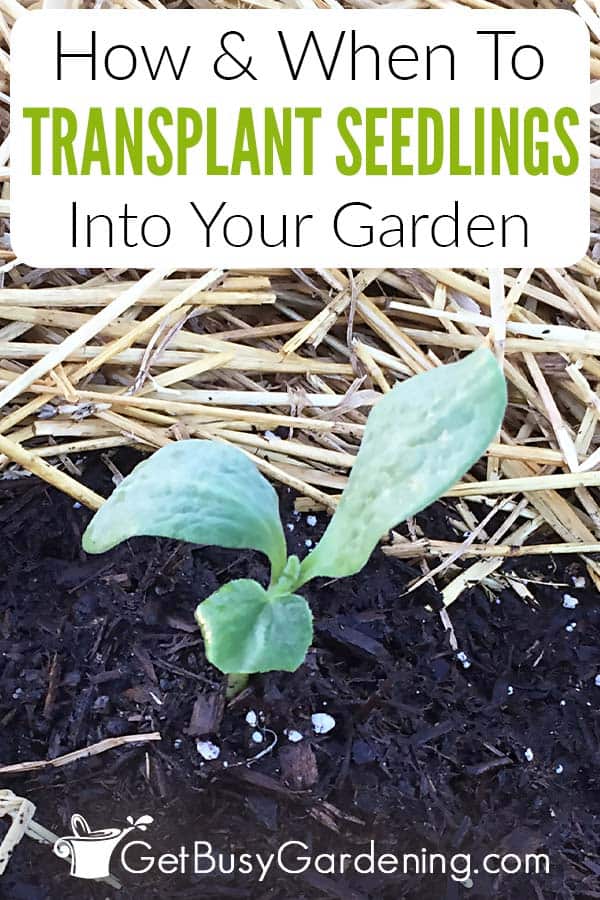
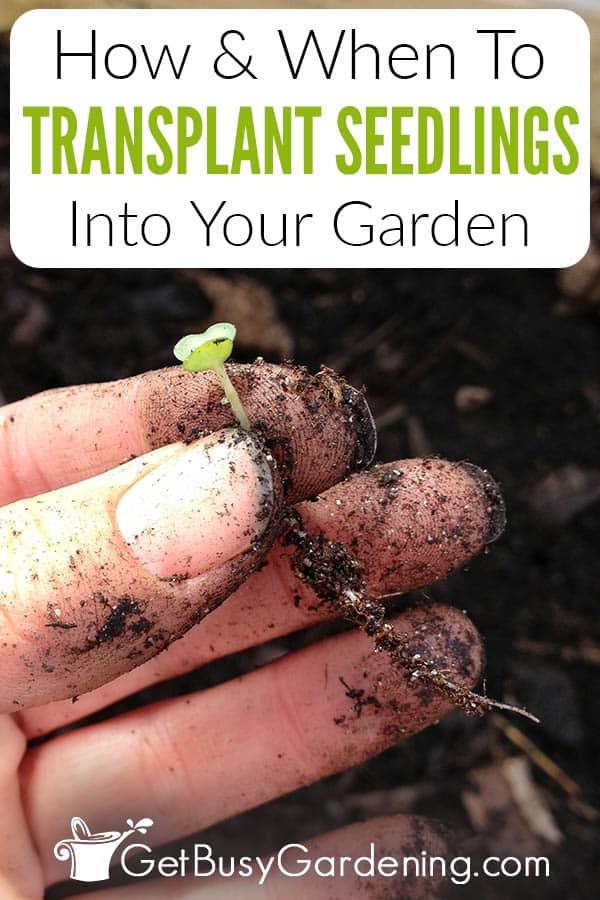
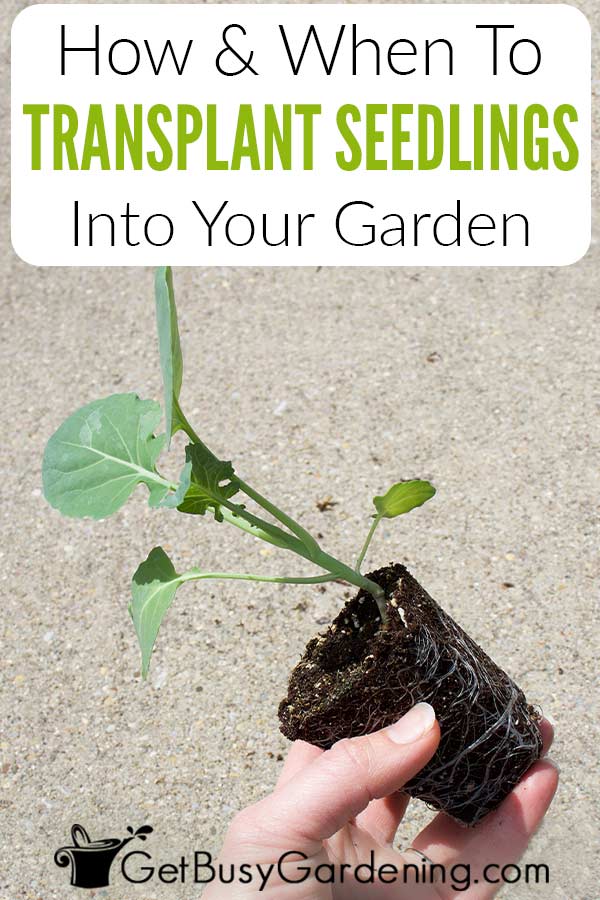

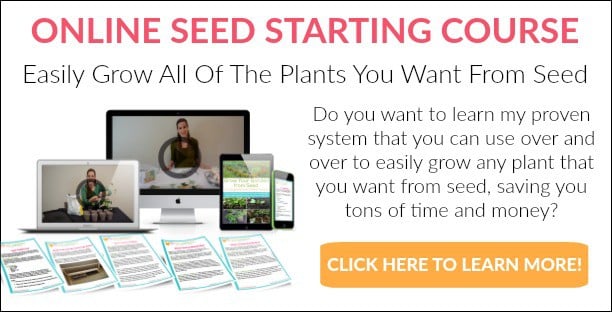

Amanda Drews says
I love this site! We just moved to a new spot in the Twin Cities and are planning out a couple acres with large areas of native gardens! Thank you for all the pictures!
Amy Andrychowicz says
Awesome to hear you love my website, thank you! You’re welcome, and good luck with your gardens.
Amy says
I am new to gardening this year and learned of hardening while reading about how to start seedlings. What I wasn’t able to determine, because I have seen no description anywhere, is how to tell if your seedlings are “hardened”. What am I looking for? My seedlings are several weeks old and most are 2-3 times taller than the containers they are growing in, but their stems are very thin and I imagine that they should be more sturdy than they are. I have been putting them out under our patio umbrella in hotter weather, but I don’t know if I am doing this correctly because I don’t know what to look for? Do you have any suggestions?
Amy Andrychowicz says
Generally it takes about 7-10 days to fully harden them before transplanting seedlings into the garden. Really the best way to tell if they are ready is once you have them in their appropriate sun exposure, and you’re able to leave them there 24 hours a day for a few days without any signs of sunburn or other damage (like from wind or rain). Here’s a detailed article about how to harden them, with tips for how to tell when they are ready.
Bob Boysen says
I lay my tomato seedlings in a trough rather than planting deep. Te soil is much warmer that way, rather than a foot into the grpond.and used to bury the stem and bend the tip up, taking a chance of breaking them I’ve learned, however. if i just lay them in the trough on a sunny day and phototropism takes care of puting the bend ib them for me. Voila! No more broken stems. Then my fertilizer mix stirred into the soil where the stem will lay, and wait patiently for the beautiful red highly edible and tasty Mortgage Lifters, Cherokee Purples, Beefsteaks, Early Goliath Hybrids, Branywines, etc to ripen.
Amy Andrychowicz says
Awesome! Thanks for sharing how you transplant your tomato seedlings. Sounds like you have a great system, and lots of success!
Jamie Szklany says
Hi Amy, I planted long sweet pepper seeds from peppers I bought in the store. They came up, we hardened them off the I planted them in the garden last week. Now they are just sitting there, they are not growing any bigger, they look healthy but there is no new growth. How long should it be before I see signs of growth
Amy Andrychowicz says
It can take plants a little while to get over their transplant shock once you move them into the garden. As long as they look healthy, and aren’t drooping, then I would start fertilizing them to give them a boost. Good luck!
Josephine says
Do you ever cover your seedlings when you first plant them, and if you do what do you use or recommend?
Thanks
Amy Andrychowicz says
The only time I would ever cover seedlings after transplanting them into the garden is if a late frost is in the forecast. In that case, I use lightweight blankets or old bed sheets. Otherwise, as long as they have been properly hardened off, there’s no need to cover them.
Josephine says
Thank you so much. Your website is great – excellent information.
Amy Andrychowicz says
You’re welcome! Thank you. 🙂
Marl I says
Do I do the same with fruit tree seedlings ?
Amy Andrychowicz says
Yes, you can follow these instructions for transplanting any type of seedling. 🙂
Marie says
These are excellent tips! I had never heard of hardening your seedlings before so I need to read that as well.
Amy Andrychowicz says
Yes, hardening them before transplanting is crucial, so don’t skip that step!